All companies are required by law to send copies of the Safety Data Sheets (SDS) with chemicals that they supply. The SDS must be supplied in the language of the recipient country.
Each SDS will contain the following sections which can be used when undertaking a COSHH assessment.
- Identification of the Substance / Mixture and of the Company / Undertaking
- Hazards Identification
- Composition / Information on Ingredients
- First aid Measures
- Firefighting Measures
- Accidental Release Measures
- Handling and Storage
- Exposure Controls / Personal Protection
- Physical and Chemical Properties
- Stability and Reactivity
- Toxicological Information
- Ecological Information
- Disposal Considerations
- Transport Information
- Regulatory Information
- Other Information.
Globally Harmonised System (GHS) of chemical labelling GHS information
Some chemicals may have more than one sign on their bottle as they pose more than one type of hazard. All chemical products that have been registered with the European Chemical Agency will have one or more of the following signs. Some products for domestic use such as washing up liquid will have a sign.
The chemical hazard symbols and their meanings.
| Chemical hazard symbol | Defintion |
|---|
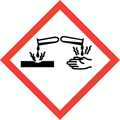 |
Corrosive (eg Sulphuric Acid, Hydrogen Peroxide, Sodium Hypochlorite, Formaldhyde) |
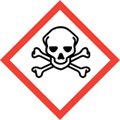 |
Acute Toxicity or Fatal (eg Acrylamide, Sodium Dodecyl Sulphate, CO, Methanol, Ethidium Bromide, Formaldehyde) |
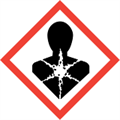 |
Health Hazard, Carcinogenic, Mutagenic, Teratogenic, Inhalation hazard, Reproductive Toxicity (eg Ethidium Bromide, Formaldehyde, CO) |
 |
Irritant (Respiratory tract, Skin or Eye) or Harmful (toxicity) (eg Hydrogen Peroxide, Ammonium Persulphate, NaDCC) |
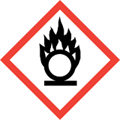 |
Oxidising agent (eg Ammonium Persulphate, Oxygen, NaDCC) |
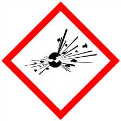 |
Explosive |
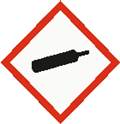 |
Gases (Hydrogen, Carbon Dioxide, Carbon Monoxide, Oxygen) |
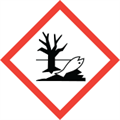 |
Environmental Hazard (Sodium Hypochlorite, NaDCC) |
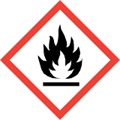 |
Flammable (eg Ethanol, Sodium Dodecyl Sulphate, Carbon Monoxide, Methanol) |
Hazard and precautionary statements
Following adoption of the Globally Harmonised System of labelling chemicals, Risk R-phrases and Safety S-phrases are being been replaced with Hazard H-statements and Precautionary P-statements, however some SDS may have both the new and older types of information.
The Hazard statements covers physical hazards such as H226 (flammable liquid and vapour), health hazards such as H350 (may cause cancer) and environmental hazards such as H401 toxic to aquatic life.
The Precautionary statements cover Preventative statements eg P263 (Avoid contact during pregnancy / while nursing), Response statements informing people what to do after contact eg P314 (Get Medical advice / attention if you feel unwell) and Storage statements eg P402 (store in a dry place).
Chemicals (Hazard Information and Packaging for supply) CHIP Information
The older system of information is based on the chemicals (Hazard Information and Packaging for supply) system of labelling which are Orange and Black signs.
Risk and safety statements
Under this system R numbers are used. These represent the Risk Statements and indicate the risk associated with the product. There may be a single risk or multiple risks.
- R39/26/27/28 means Very Toxic: danger of very serious irreversible effects through inhalation, in contact with skin and if swallowed.
- R 23/24/25 Toxic by inhalation, in contact with skin and if swallowed. Phenol bears this risk phrase.
- R36 Irritating to eyes. This phrase would describe acetonitrile and mercaptoethanol.
- R 48/20/22 Harmful : danger of serious damage to health by Prolonged exposure through inhalation and if swallowed. Chloroform is such a chemical.
S numbers are Safety precautions / phrases used to inform people what they should do to minimise the chance of injury being sustained.
- S27 Take off immediately all contaminated clothing.
- S1 Keep locked up. This would apply to cyanide and its compounds.
- S16 Keep away from sources of ignition - No smoking. This would apply to acetonitrile.
- S45 In case of accident or if you feel unwell, seek medical advice immediately (show the label where possible). This applies to phenol.
- S36/37 Wear suitable protective clothing and gloves.
Work Exposure Limit (WEL) information
Certain chemicals used in SGUL such as Formaldehyde have a work exposure limit associated with them. The limit is the maximum of the chemical that a person can inhale over either a 15 minute period or an eight hour period. The aim is always to prevent people being exposed to the chemical if at all possible. If the person must be exposed to the chemical then measures such as respiratory protection may need to be considered in the risk assessment.
Information on Work Exposure Limits can be obtained from the publication EH40 / 2005(PDF).
Responsibility as a producer of chemicals
Individuals who produce chemicals such as peptides for shipment for other institutions could have duties under the new regulations.